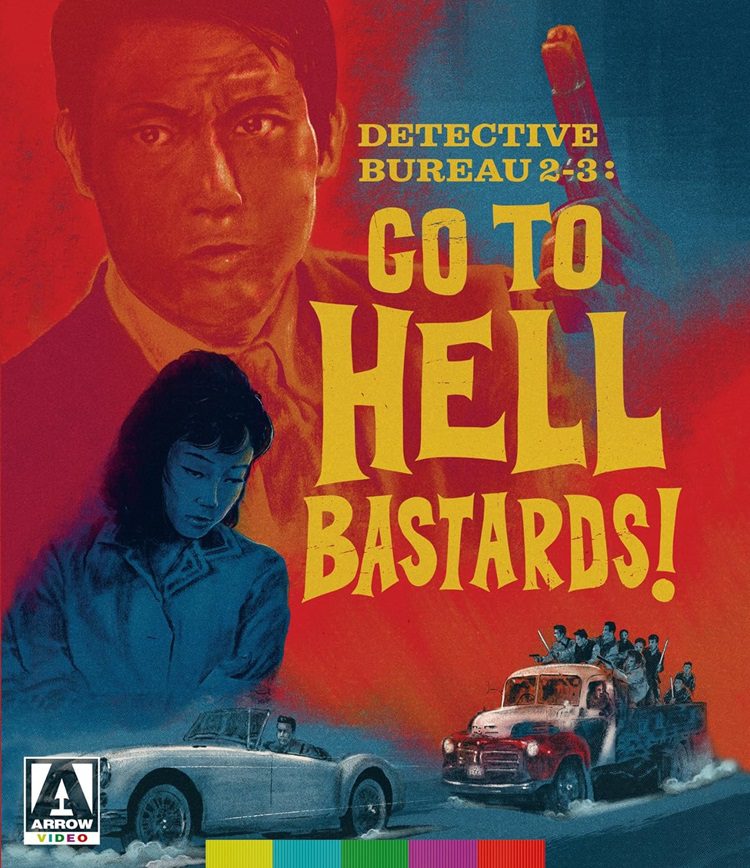
Seijun Suzuki, one of the stable of directors at Nikkatsu in the ’50s and ’60s, Japan’s oldest film studio, was fired in 1967 after his imaginative and visually inventive Branded to Kill completely confused the studio head. It was the culmination of an increasingly prickly relationship between Suzuki and the studio, as he worked very hard to put a personal touch and visual flair on what were standard studio genre scripts. He would happily undermine the generic beats and tone of the violent gangster movies he was tasked with making, if it would allow him to get something interesting on the screen.
Youth of the Beast, his second of four films released in 1963, was Suzuki’s own pick for his first true signature film, but even before then his flair for eccentricity and playing with space and time in his editing and lighting was already being developed, and can sometimes be seen in nascent form in earlier films, including Detective Bureau 2-3: Go to Hell Bastards! This light detective romp has an irreverent tone towards its story and an occasionally employs a striking visual style that elevates a fairly routine “yakuza vs. cops” story.
Jo Shishido stars as Hideo Tajima, a freelance detective who somehow gets hired on by the cops to go undercover with the yakuza. The cops need to infiltrate a shadowy local mob that has robbed the other more established yakuza gangs while they were burgling an American military base, but the specifics of the story are largely glossed over, and are a bare skeleton on which Suzuki hangs a succession of engaging scenes that only loosely hang together as a coherent plot.
Though Shishido is going undercover, there doesn’t seem to be an instant where the yakuza don’t figure he’s a cop, and he only ever gets any real information from them after he’s definitively found out. While trying to play it cool in a club where the singer is an ex-girlfriend of his, he ends up doing a song-and-dance number with her while trying to keep her from spilling his real identity. The yakuza boss has a pretty fiancé who of course falls for Shishido, though he spends more time groping her to plan recording devices on her clothes instead of making any real passes.
Though the story is ostensibly a violent gangster drama and it takes place in essentially world-bound dingy alleys, warehouses, and nightclubs, Suzuki finds some places to show off his visual flair. Manabe, the yakuza whom Shishido is ingratiating himself with, has a strange sado-masochistic relationship with his girlfriend. He accuses her of having a sideman and slaps her around, which she doesn’t seem to mind at all. In this scene, half the room is bathed in red light, the other in a sickly yellow and white. The colors are barely motivated by on-screen sources – they just look cool, and give the very odd scene (which ends with Manabe tearing the apartment apart looking for her other man, the girl giggling all the while) an otherworldly feeling.
Since it’s not necessarily a consistent visual style and doesn’t go to the extremes that would later force Suzuki out of his job, Detective Bureau 2-3: Go to Hell Bastards!‘s more outlandish visual elements are more icing than cake. The story is enjoyable more as a series of interesting and unusual scenes than as a tight or engaging gangster plot. There’s plenty of stock Nikkatsu actors playing mostly stock gangster parts. Jo Shishido is a likeable actor. To me, it seems his outward confidence and swagger never seems to reach his eyes – he always seems to be on the verge of not quite pulling off being a tough guy, which gives him a dimension a more sincere performance would lack. This didn’t make him as big a draw as other Nikkatsu Diamond Guys, though, and it wasn’t long before he was back to playing second-fiddle gangsters supporting bigger stars.
Detective Bureau 2-3: Go to Hell Bastards! is an Arrow Video release on Blu-ray. Besides the film and gallery of production still, there’s a booklet with an overview of the film and its historical context by Jasper Sharp and a great 30 minute video critical discussion of the film by Tony Rayns, both of whose insights have been present on earlier Arrow video releases.